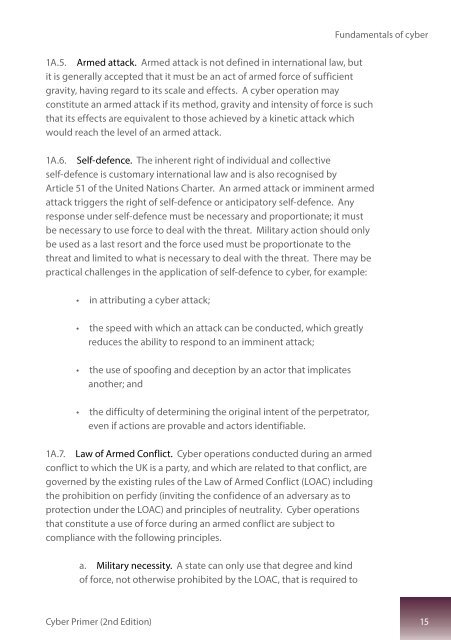Cyber Primer
AEWhbF
AEWhbF
Create successful ePaper yourself
Turn your PDF publications into a flip-book with our unique Google optimized e-Paper software.
1A.5. Armed attack. Armed attack is not defined in international law, but<br />
it is generally accepted that it must be an act of armed force of sufficient<br />
gravity, having regard to its scale and effects. A cyber operation may<br />
constitute an armed attack if its method, gravity and intensity of force is such<br />
that its effects are equivalent to those achieved by a kinetic attack which<br />
would reach the level of an armed attack.<br />
1A.6. Self-defence. The inherent right of individual and collective<br />
self-defence is customary international law and is also recognised by<br />
Article 51 of the United Nations Charter. An armed attack or imminent armed<br />
attack triggers the right of self-defence or anticipatory self-defence. Any<br />
response under self-defence must be necessary and proportionate; it must<br />
be necessary to use force to deal with the threat. Military action should only<br />
be used as a last resort and the force used must be proportionate to the<br />
threat and limited to what is necessary to deal with the threat. There may be<br />
practical challenges in the application of self-defence to cyber, for example:<br />
• in attributing a cyber attack;<br />
Fundamentals of cyber<br />
• the speed with which an attack can be conducted, which greatly<br />
reduces the ability to respond to an imminent attack;<br />
• the use of spoofing and deception by an actor that implicates<br />
another; and<br />
• the difficulty of determining the original intent of the perpetrator,<br />
even if actions are provable and actors identifiable.<br />
1A.7. Law of Armed Conflict. <strong>Cyber</strong> operations conducted during an armed<br />
conflict to which the UK is a party, and which are related to that conflict, are<br />
governed by the existing rules of the Law of Armed Conflict (LOAC) including<br />
the prohibition on perfidy (inviting the confidence of an adversary as to<br />
protection under the LOAC) and principles of neutrality. <strong>Cyber</strong> operations<br />
that constitute a use of force during an armed conflict are subject to<br />
compliance with the following principles.<br />
a. Military necessity. A state can only use that degree and kind<br />
of force, not otherwise prohibited by the LOAC, that is required to<br />
<strong>Cyber</strong> <strong>Primer</strong> (2nd Edition) 15


